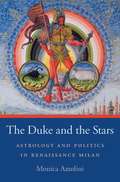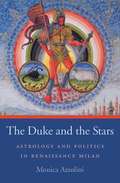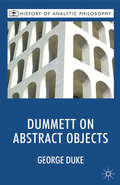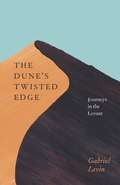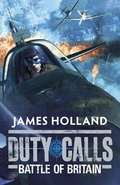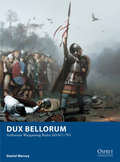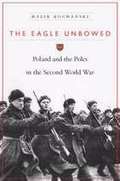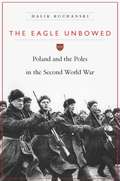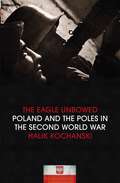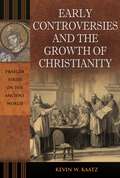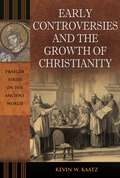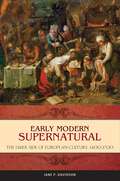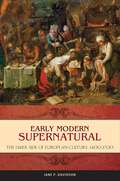- Table View
- List View
The Duke and the Stars: Astrology And Politics In Renaissance Milan (I Tatti studies in Italian Renaissance history #5)
by Monica AzzoliniThe Duke and the Stars explores science and medicine as studied and practiced in fifteenth-century Italy, including how astrology was taught in relation to astronomy. It illustrates how the “predictive art” of astrology was often a critical, secretive source of information for Italian Renaissance rulers, particularly in times of crisis.
The Duke and the Stars: Astrology And Politics In Renaissance Milan (I Tatti studies in Italian Renaissance history #5)
by Monica AzzoliniThe Duke and the Stars explores science and medicine as studied and practiced in fifteenth-century Italy, including how astrology was taught in relation to astronomy. It illustrates how the “predictive art” of astrology was often a critical, secretive source of information for Italian Renaissance rulers, particularly in times of crisis.
The Duke is Mine: Number 3 in series (Happy Ever After #3)
by Eloisa James'Nothing gets me to a bookstore faster than Eloisa James' - Julia QuinnOnce upon a time, not so very long ago...Tarquin, the powerful Duke of Sconce, knows perfectly well that the decorous and fashionably slender Georgiana Lytton will make him a proper duchess. So why can't he stop thinking about her twin sister, the curvy, headstrong, and altogether unconventional Olivia? Not only is Olivia betrothed to another man, but their improper - albeit intoxicating - flirtation makes her unsuitability all the more clear. Determined to make a perfect match, he methodically cuts Olivia from his thoughts, allowing logic and duty to triumph over passion . . . until, in his darkest hour, Tarquin begins to question whether perfection has anything to do with love. To win Olivia's hand he would have to give up all the beliefs he holds most dear, and surrender heart, body and soul - but it may already be too late.'Eloisa James is extraordinary' - Lisa Kleypas'Romance writing does not get much better than this' - People
Dummett on Abstract Objects (History of Analytic Philosophy)
by G. DukeThis historically-informed critical assessment of Dummett's account of abstract objects, examines in detail some of the Fregean presuppositions of Dummett's account whilst also engaging with phenomenological approaches and recent work on the problem of abstract entities.
The Dune's Twisted Edge: Journeys in the Levant
by Gabriel Levin“How to speak of the imaginative reach of a land habitually seen as a seedbed of faiths and heresies, confluences and ruptures . . . trouble spot and findspot, ruin and renewal, fault line and ragged clime, with a medley of people and languages once known with mingled affection and wariness as Levantine?” So begins poet Gabriel Levin in his journeys in the Levant, the exotic land that stands at the crossroads of western Asia, the eastern Mediterranean, and northeast Africa. Part travelogue, part field guide, and part literary appreciation, The Dune’s Twisted Edge assembles six interlinked essays that explore the eastern seaboard of the Levant and its deserts, bringing to life this small but enigmatic part of the world. Striking out from his home in Jerusalem in search of a poetics of the Fertile Crescent, Levin probes the real and imaginative terrain of the Levant, a place that beckoned to him as a source of wonder and self-renewal. His footloose travels take him to the Jordan Valley; to Wadi Rumm south of Petra; to the semiarid Negev of modern-day Israel and its Bedouin villages; and, in his recounting of the origins of Arabic poetry, to the Empty Quarter of Arabia where the pre-Islamic poets once roamed. His meanderings lead to encounters with a host of literary presences: the wandering poet-prince Imru al-Qays, Byzantine empress Eudocia, British naturalist Henry Baker Tristram, Herman Melville making his way to the Dead Sea, and even New York avant-garde poet Frank O’Hara. When he is not confronting ghosts, Levin finds himself stumbling upon the traces of vanished civilizations. He discovers a ruined Umayyad palace on the outskirts of Jericho, the Greco-Roman hot springs near the Sea of Galilee, and Nabatean stick figures carved on stones in the sands of Jordan. Vividly evoking the landscape, cultures, and poetry of this ancient region, The Dune’s Twisted Edge celebrates the contested ground of the Middle East as a place of compound myths and identities.
The Dune's Twisted Edge: Journeys in the Levant
by Gabriel Levin“How to speak of the imaginative reach of a land habitually seen as a seedbed of faiths and heresies, confluences and ruptures . . . trouble spot and findspot, ruin and renewal, fault line and ragged clime, with a medley of people and languages once known with mingled affection and wariness as Levantine?” So begins poet Gabriel Levin in his journeys in the Levant, the exotic land that stands at the crossroads of western Asia, the eastern Mediterranean, and northeast Africa. Part travelogue, part field guide, and part literary appreciation, The Dune’s Twisted Edge assembles six interlinked essays that explore the eastern seaboard of the Levant and its deserts, bringing to life this small but enigmatic part of the world. Striking out from his home in Jerusalem in search of a poetics of the Fertile Crescent, Levin probes the real and imaginative terrain of the Levant, a place that beckoned to him as a source of wonder and self-renewal. His footloose travels take him to the Jordan Valley; to Wadi Rumm south of Petra; to the semiarid Negev of modern-day Israel and its Bedouin villages; and, in his recounting of the origins of Arabic poetry, to the Empty Quarter of Arabia where the pre-Islamic poets once roamed. His meanderings lead to encounters with a host of literary presences: the wandering poet-prince Imru al-Qays, Byzantine empress Eudocia, British naturalist Henry Baker Tristram, Herman Melville making his way to the Dead Sea, and even New York avant-garde poet Frank O’Hara. When he is not confronting ghosts, Levin finds himself stumbling upon the traces of vanished civilizations. He discovers a ruined Umayyad palace on the outskirts of Jericho, the Greco-Roman hot springs near the Sea of Galilee, and Nabatean stick figures carved on stones in the sands of Jordan. Vividly evoking the landscape, cultures, and poetry of this ancient region, The Dune’s Twisted Edge celebrates the contested ground of the Middle East as a place of compound myths and identities.
Duty Calls: World War 2 Fiction (Duty Calls)
by James HollandPilot officer Archie Jackson, 19, is in control of the RAF's newest fighter aircraft, a Supermarine Spitfire.Now he has the Luftwaffe in his sights and only one thing matters: defending Britain. Suddenly planes are falling from the sky, exploding and spiralling into the English Channel.France has fallen and the swastika flies over Occupied Europe. Only these young pilots - barely out of boyhood - stand between Britain and a Nazi invasion . . . Duty Calls: Battle of Britain, throws you deep into the heart - and horror - of Britain's darkest, and finest, hour.** Historian James Holland is the bestselling author of the Jack Tanner adult war fiction books. Duty Calls is his first series for younger readers, and showcases his expertise on the Second World War. ** James Holland presented Battle of Britain: The Real Story on BBC2.
Dux Bellorum: Arthurian Wargaming Rules AD367–793 (Osprey Wargames #1)
by Daniel Mersey José Daniel PeñaThe Dark Age of Britain, from the middle of the 4th century to the end of the 8th, was a time of violence and warfare, when charismatic warlords such as the fabled King Arthur could gather together armies and carve out their own kingdoms. With this new set of wargames rules, players can take on the role of these warlords and command their own armies on the tabletop. Written by the author of the popular Glutter of Ravens rules set, Dux Bellorum is an element-based system, where each base of figures represents 50 fighting men. Each player has a specific number of points with which to construct his force and can choose a Late Roman, Romano-British, Welsh, Saxon, Pictish, Irish, or Sea Raider army, amongst others. The game is then played out following a set of simple, fast-paced rules. A completely self-contained gaming system, Dux Bellorum is perfect for gamers who are looking for a way into fighting Dark Age battles without investing a lot of time or money in larger rulesets.
Dying for Victorian Medicine: English Anatomy and its Trade in the Dead Poor, c.1834 - 1929
by E. HurrenThe first book to provide a detailed analysis of the body-trafficking networks of the dead poor that underpinned the expansion of medical education from Victorian times. With an even-handed approach to the business of anatomy, Hurren uses remarkable case histories which still echo a vibrant body-business on the internet today in a biomedical age.
Dynamics of Memory and Identity in Contemporary Europe
by Eric Langenbacher, Bill Niven, and Ruth WittlingerThe collapse of the Iron Curtain, the renationalization of eastern Europe, and the simultaneous eastward expansion of the European Union have all impacted the way the past is remembered in today’s eastern Europe. At the same time, in recent years, the Europeanization of Holocaust memory and a growing sense of the need to stage a more “self-critical” memory has significantly changed the way in which western Europe commemorates and memorializes the past. The increasing dissatisfaction among scholars with the blanket, undifferentiated use of the term “collective memory” is evolving in new directions. This volume brings the tension into focus while addressing the state of memory theory itself.
Dynamite, Treason & Plot: Terrorism in Victorian & Edwardian London (History Press Ser.)
by Simon WebbIn the years since the 7/7 attacks on the London transport system, many people in Britain seem to have become convinced that we live in uniquely dangerous times and that the threat from terrorism has never been greater. In fact, terrorist attacks have been a feature of life in London for many years. The worst terrorist bombing in the capital before 7/7 took place in 1867, when twelve people were killed in an explosion in Clerkenwell. The first person to be killed by a bombing on the Tube died in 1897. From the deadly Fenian campaign against high-profile targets in the capital to the Anarchist bombing of the Royal Observatory at Greenwich, late nineteenth- and early twentieth-century London saw a constant succession of terrorist threats. This book details the emergence of modern terrorism, a phenomenon which has its roots in Victorian London.
Dynasty and Piety: Archduke Albert (1598-1621) and Habsburg Political Culture in an Age of Religious Wars
by Luc DuerlooThe youngest son of Emperor Maximilian II, and nephew of Philip II of Spain, Archduke Albert (1559-1621) was originally destined for the church. However, dynastic imperatives decided otherwise and in 1598, upon his marriage to Philip's daughter, the Infanta Isabella Clara Eugenia, he found himself ruler of the Habsburg Netherlands, one of the most dynamic yet politically unstable territories in early-modern Europe. Through an investigation of Albert's reign, this book offers a new and fuller understanding of international events of the time, and the Habsburg role in them. Drawing on a wide range of archival and visual material, the resulting study of Habsburg political culture demonstrates the large degree of autonomy enjoyed by the archducal regime, which allowed Albert and his entourage to exert a decisive influence on several crucial events: preparing the ground for the Anglo-Spanish peace of 1604 by the immediate recognition of King James, clearing the way for the Twelve Years' Truce by conditionally accepting the independence of the United Provinces, reasserting Habsburg influence in the Rhineland by the armed intervention of 1614 and devising the terms of the Oñate Treaty of 1617. In doing so the book shows how they sought to initiate a realistic policy of consolidation benefiting the Spanish Monarchy and the House of Habsburg. Whilst previous work on the subject has tended to concentrate on either the relationship between Spain and the Netherlands or between Spain and the Empire, this book offers a far deeper and much more nuanced insight in how the House of Habsburg functioned as a dynasty during these critical years of increasing religious tensions. Based on extensive research in the archives left by the archducal regime and its diplomatic partners or rivals, it bridges the gap between the reigns of Philip II and Philip IV and puts research into the period onto a fascinating new basis.
Dynasty and Piety: Archduke Albert (1598-1621) and Habsburg Political Culture in an Age of Religious Wars
by Luc DuerlooThe youngest son of Emperor Maximilian II, and nephew of Philip II of Spain, Archduke Albert (1559-1621) was originally destined for the church. However, dynastic imperatives decided otherwise and in 1598, upon his marriage to Philip's daughter, the Infanta Isabella Clara Eugenia, he found himself ruler of the Habsburg Netherlands, one of the most dynamic yet politically unstable territories in early-modern Europe. Through an investigation of Albert's reign, this book offers a new and fuller understanding of international events of the time, and the Habsburg role in them. Drawing on a wide range of archival and visual material, the resulting study of Habsburg political culture demonstrates the large degree of autonomy enjoyed by the archducal regime, which allowed Albert and his entourage to exert a decisive influence on several crucial events: preparing the ground for the Anglo-Spanish peace of 1604 by the immediate recognition of King James, clearing the way for the Twelve Years' Truce by conditionally accepting the independence of the United Provinces, reasserting Habsburg influence in the Rhineland by the armed intervention of 1614 and devising the terms of the Oñate Treaty of 1617. In doing so the book shows how they sought to initiate a realistic policy of consolidation benefiting the Spanish Monarchy and the House of Habsburg. Whilst previous work on the subject has tended to concentrate on either the relationship between Spain and the Netherlands or between Spain and the Empire, this book offers a far deeper and much more nuanced insight in how the House of Habsburg functioned as a dynasty during these critical years of increasing religious tensions. Based on extensive research in the archives left by the archducal regime and its diplomatic partners or rivals, it bridges the gap between the reigns of Philip II and Philip IV and puts research into the period onto a fascinating new basis.
The Eagle Unbowed: Poland And The Poles In The Second World War
by Halik KochanskiWorld War II gripped Poland as it did no other country. Invaded by Germany and the USSR, it was occupied from the first day of war to the last, and then endured 44 years behind the Iron Curtain while its wartime partners celebrated their freedom. The Eagle Unbowed tells, for the first time, the story of Poland’s war in its entirety and complexity.
The Eagle Unbowed: Poland And The Poles In The Second World War
by Halik KochanskiWorld War II gripped Poland as it did no other country. Invaded by Germany and the USSR, it was occupied from the first day of war to the last, and then endured 44 years behind the Iron Curtain while its wartime partners celebrated their freedom. The Eagle Unbowed tells, for the first time, the story of Poland’s war in its entirety and complexity.
The Eagle Unbowed: Poland and the Poles in the Second World War
by Halik KochanskiIn Halik Kochanski's extraordinary book, the untold story of Poland and the Poles in the Second World War is finally heard By almost every measure the fate of the inhabitants of Poland was the most terrible of any group in the Second World War. Following the destruction of its armed forces in the autumn of 1939, the Republic of Poland was partitioned between Nazi and Soviet forces and officially ceased to exist. Racial violence and ideological conformity were at the very heart of the new regimes. As the war progressed millions of Poles were killed, with each phase unleashing a further round, from the industrialised genocide of Treblinka to the crushing of the Warsaw Rising. Polish Jews were all to be murdered, Christians reduced to a semi-literate slave class. In this powerful and original new book Halik Kochanski has written perhaps the most important 'missing' work on the whole conflict: an attempt in a single volume to describe both the fate of those trapped within occupied Poland and of those millions of Poles who were able to escape. Reviews: 'An extraordinary achievement ... a brilliant exercise in historiography ... Kochanski neither debunks nor sensationalises. She has no ideological axe to grind, and makes balanced use of family experience and interview material as against the official record and a handed-down sentimental consensus. The truth is far more powerful than the legend. It's great history writing' Herald 'A superb account of Poland during the second world war ... The pain and loss ... is poignantly evoked by Kochanski ... The Eagle Unbowed, a model history, conveys with harrowing immediacy the plight of the Polish people in the conflict' Ian Thomson, Spectator 'A remarkable book ... [Kochanski] brings to the subject not only an impressive grasp of the military and political context, but also a balance, neutrality and honesty few could manage, combined with the intelligence, imagination and empathy necessary to grasp the true depth of the experience she recounts ... This book is history at its best.' Standpoint'Poland's war was so terrible as to almost defy summary ... this book is opinionated, fluid and forceful' Oliver Bullough, New StatesmanAbout the author: Halik Kochanski read Modern History at Balliol College, Oxford and then completed a PhD at King's College London. She has taught at both King's College London and University College London and presented papers to a number of military history conferences. She has written a number of articles and is the author of Sir Garnet Wolseley: Victorian Hero (1999). She is a Fellow of the Royal Historical Society. She has been a member of the councils of the Army Records Society and Society for Army Historical Research and remains a member of both societies. She is also a member of the British Commission for Military History and the Institute for Historical Research. She is currently a judge for the Templer Medal book prize.
Éamonn Ceannt: Signatory of the 1916 Proclamation (Irish Revolutionaries Ser.)
by William HenryÉamonn Ceannt was executed at Kilmainham Gaol on 8 May 1916, along with Con Colbert, Seán Heuston and Michael Mallin, for their part in the Easter Rising. Ceannt was one of the seven signatories of the Proclamation of the Irish Republic read by Patrick Pearse outside the GPO on that Easter Monday. He had led the rebel occupation of the South Dublin Union, and despite having been vastly outnumbered his volunteers were not overpowered but ordered to surrender by Pearse. Éamonn Ceannt, together with Patrick Pearse and Joseph Plunkett, was instrumental in planning the rebellion. He had joined the Gaelic League in 1899, where he met Pearse and Eoin MacNeill. He became a member of the Irish Republican Brotherhood in 1912 and became a founding member of the Irish Volunteeers the following year. This is the only biography of this brilliant military tactician and key player in the story of 1916.
Early Controversies and the Growth of Christianity (Praeger Series on the Ancient World)
by Kevin W. KaatzThis revealing history examines the controversies, maneuvering, and political wrangling that occupied the Christian Church for the first four centuries of its existence.Drawing from primary texts, Early Controversies and the Growth of Christianity reveals how the religion was formed through a series of conflicts that occurred primarily between Christian groups. Presenting a close examination of the first four centuries of Christian history through the lens of the controversies that animated, disturbed, and finally formed the Church, the book will enable readers to become familiar with the lives and writings of the early Christians and to better understand the fascinating history of early Christianity.The book focuses on several major early controversies. These include controversies surrounding the apostle Paul; controversies concerning the apostolic fathers, especially the idea of a pope and the role of the bishop/priest; Marcion and his influence; Manichaeism and Gnosticism; persecution and the Dontatists; Arianism; the rise of the bishop in the late 4th century; and power struggles between church and state. Each chapter focuses on the primary texts and key players in the battle over what would finally become orthodox Christianity, demystifying many poorly understood events that ultimately helped define today's Church.
Early Controversies and the Growth of Christianity (Praeger Series on the Ancient World)
by Kevin W. KaatzThis revealing history examines the controversies, maneuvering, and political wrangling that occupied the Christian Church for the first four centuries of its existence.Drawing from primary texts, Early Controversies and the Growth of Christianity reveals how the religion was formed through a series of conflicts that occurred primarily between Christian groups. Presenting a close examination of the first four centuries of Christian history through the lens of the controversies that animated, disturbed, and finally formed the Church, the book will enable readers to become familiar with the lives and writings of the early Christians and to better understand the fascinating history of early Christianity.The book focuses on several major early controversies. These include controversies surrounding the apostle Paul; controversies concerning the apostolic fathers, especially the idea of a pope and the role of the bishop/priest; Marcion and his influence; Manichaeism and Gnosticism; persecution and the Dontatists; Arianism; the rise of the bishop in the late 4th century; and power struggles between church and state. Each chapter focuses on the primary texts and key players in the battle over what would finally become orthodox Christianity, demystifying many poorly understood events that ultimately helped define today's Church.
Early Modern Drama and the Bible: Contexts and Readings, 1570-1625 (Early Modern Literature in History)
by Adrian StreeteEarly modern drama is steeped in biblical language, imagery and stories. This collection examines the pervasive presence of scripture on the early modern stage. Exploring plays by writers such as Shakespeare, Marlowe, Middleton, and Webster, the contributors show how theatre offers a site of public and communal engagement with the Bible.
Early Modern Encounters with the Islamic East: Performing Cultures (Transculturalisms, 1400-1700)
by Sabine Schülting Sabine Lucia Müller Ralf HertelAn exploration of early modern encounters between Christian Europe and the (Islamic) East from the perspective of performance studies and performativity theories, this collection focuses on the ways in which these cultural contacts were acted out on the real and metaphorical stages of theatre, literature, music, diplomacy and travel. The volume responds to the theatricalization of early modern politics, to contemporary anxieties about the tension between religious performance and belief, to the circulation of material objects in intercultural relations, and the eminent role of theatre and drama for the (re)imagination and negotiation of cultural difference. Contributors examine early modern encounters with and in the East using an innovative combination of literary and cultural theories. They stress the contingent nature of these contacts and demonstrate that they can be read as moments of potentiality in which the future of political and economic relations - as well as the players' cultural, religious and gender identities - are at stake.
Early Modern Encounters with the Islamic East: Performing Cultures (Transculturalisms, 1400-1700)
by Sabine Schülting Sabine Lucia Müller Ralf HertelAn exploration of early modern encounters between Christian Europe and the (Islamic) East from the perspective of performance studies and performativity theories, this collection focuses on the ways in which these cultural contacts were acted out on the real and metaphorical stages of theatre, literature, music, diplomacy and travel. The volume responds to the theatricalization of early modern politics, to contemporary anxieties about the tension between religious performance and belief, to the circulation of material objects in intercultural relations, and the eminent role of theatre and drama for the (re)imagination and negotiation of cultural difference. Contributors examine early modern encounters with and in the East using an innovative combination of literary and cultural theories. They stress the contingent nature of these contacts and demonstrate that they can be read as moments of potentiality in which the future of political and economic relations - as well as the players' cultural, religious and gender identities - are at stake.
Early Modern Supernatural: The Dark Side of European Culture, 1400–1700 (Praeger Series on the Early Modern World)
by Jane P. DavidsonDevils, ghosts, poltergeists, werewolves, and witches are all covered in this book about the "dark side" of supernatural beliefs in early modern Europe, tapping period literature, folklore, art, and scholarly writings in its investigation.The dark side of early modern European culture could be deemed equal in historical significance to Christianity based on the hundreds of books that were printed about the topic between 1400 and 1700. Famous writers and artists like William Shakespeare and Albrecht Dürer depicted the dark side in their work, and some of the first printed books in Europe were about witches. The pervasive representation of these monsters and apparitions in period literature, folklore, and art clearly reflects their power to inspire fear and superstition, but also demonstrates how integral they were to early modern European culture.This unique book addresses topics of the supernatural within the context of the early modern period in Europe, covering "mythical" entities such as devils, witches, ghosts, poltergeists, and werewolves in detail and examining how they fit in with the emerging new scientific method of the time. This unique combination of cultural studies for the period is ideal for undergraduate students and general readers.
Early Modern Supernatural: The Dark Side of European Culture, 1400–1700 (Praeger Series on the Early Modern World)
by Jane P. DavidsonDevils, ghosts, poltergeists, werewolves, and witches are all covered in this book about the "dark side" of supernatural beliefs in early modern Europe, tapping period literature, folklore, art, and scholarly writings in its investigation.The dark side of early modern European culture could be deemed equal in historical significance to Christianity based on the hundreds of books that were printed about the topic between 1400 and 1700. Famous writers and artists like William Shakespeare and Albrecht Dürer depicted the dark side in their work, and some of the first printed books in Europe were about witches. The pervasive representation of these monsters and apparitions in period literature, folklore, and art clearly reflects their power to inspire fear and superstition, but also demonstrates how integral they were to early modern European culture.This unique book addresses topics of the supernatural within the context of the early modern period in Europe, covering "mythical" entities such as devils, witches, ghosts, poltergeists, and werewolves in detail and examining how they fit in with the emerging new scientific method of the time. This unique combination of cultural studies for the period is ideal for undergraduate students and general readers.
Early Modern Things: Objects and their Histories, 1500-1800
by Paula FindlenWhat can we learn about the past by studying things? How does the meaning of things, and our relationship to them, change over time? This fascinating collection taps a rich vein of recent scholarship to explore a variety of approaches to the material culture of the early modern world (c.1500-1800). Divided into six parts this book explores; the ambiguity of things, representing things, making things, empires of things, consuming things and lastly the power of things. Spanning across the early modern world, from Ming dynasty China to Georgian England, and from Ottoman Egypt to Spanish America, the authors provide a generous set of examples in how to study the circulation, use, consumption and, most fundamentally, the nature of things themselves. Drawing on a broad range of disciplinary perspectives and lavishly illustrated, Early Modern Things supplies fresh and provocative insights into how objects – ordinary and extraordinary, secular and sacred, natural and man-made – came to define some of the key developments of the early modern world. This book will be essential reading for all those interested in the early modern world.
